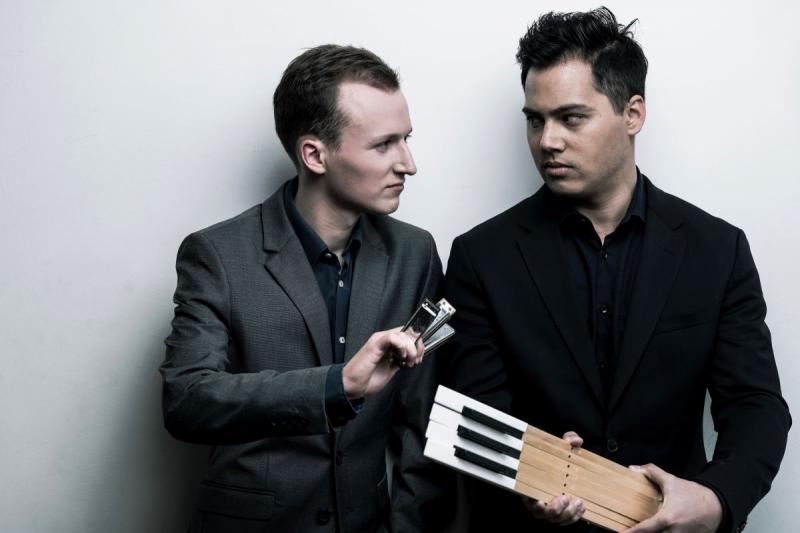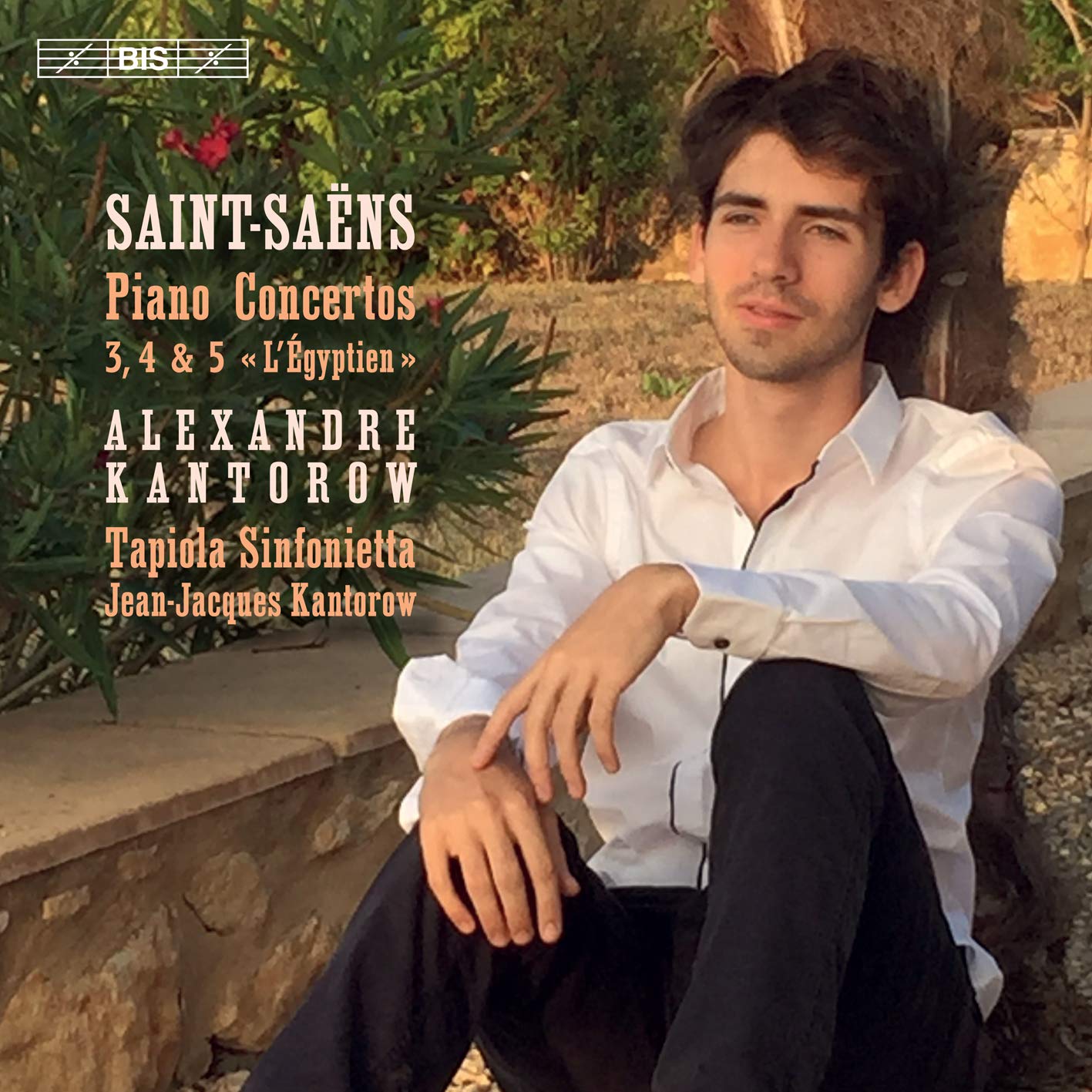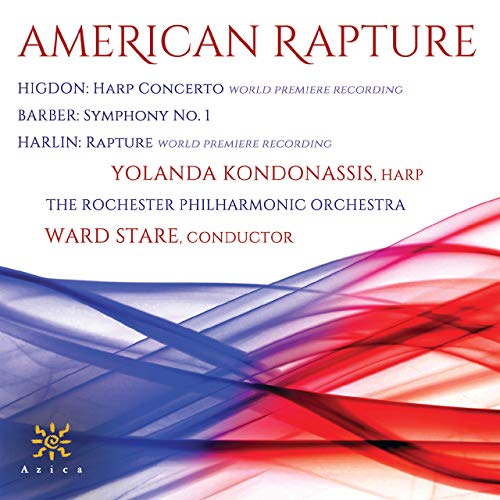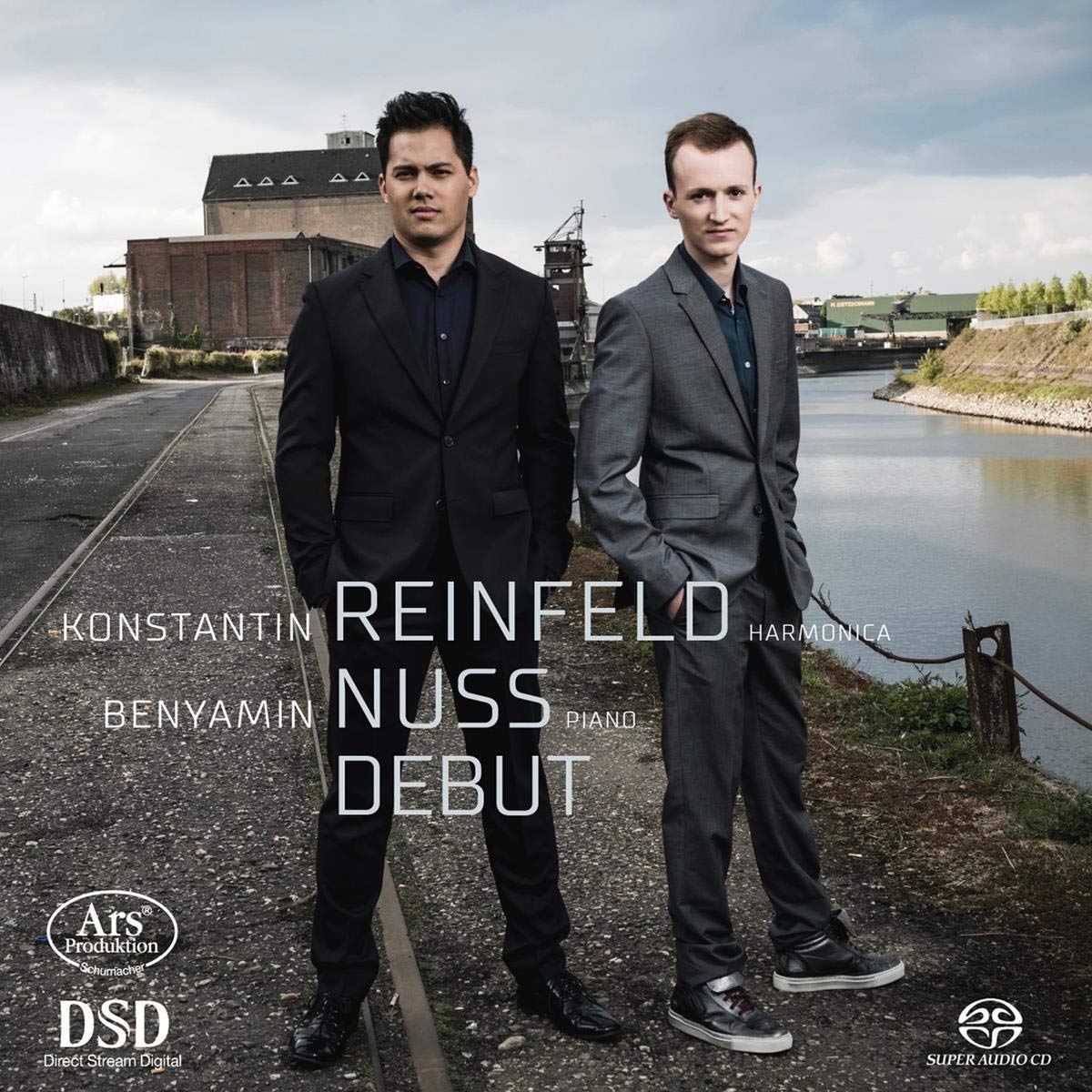Classical CDs Weekly: Saint-Saëns, Yolanda Kondonassis, Konstantin Reinfeld & Benyamin Nuss | reviews, news & interviews
Classical CDs Weekly: Saint-Saëns, Yolanda Kondonassis, Konstantin Reinfeld & Benyamin Nuss
Classical CDs Weekly: Saint-Saëns, Yolanda Kondonassis, Konstantin Reinfeld & Benyamin Nuss
A travelogue disguised as a piano concerto, plus music for harp and harmonica

 Saint-Saëns: Piano Concertos 3, 4 & 5 Alexandre Kantorow (piano), Tapiola Sinfonietta/Jean-Jacques Kantorow (BIS)
Saint-Saëns: Piano Concertos 3, 4 & 5 Alexandre Kantorow (piano), Tapiola Sinfonietta/Jean-Jacques Kantorow (BIS)
Saint-Saëns’ five piano concertos are a pleasure no one need feel guilty about indulging in. My current go-to cycle is a scratchy 1950s French set from Jean-Marie Darre, full of fizz and colour. Does Alexandre Kantorow measure up? Definitely: this generously filled CD is electrifying. Why not begin with Concerto No 5, a late work written when the composer's star was in the descendant, upstarts like Debussy and Ravel about to steal Saint-Saëns’ thunder. Subtitled “L’Égyptien” and composed in Luxor, it has a staggering slow movement, “a sort of Eastern journey that goes all the way to the Far East”. Saint-Saëns quotes a melody sung by ferrymen on the Nile before suggesting the noises of crickets and frogs. He also throws in convincing guitar effects and an ear-tickling Javanese gamelan. You won't have heard anything quite like it. Saint-Saëns’ goofy finale expresses “the joy of a sea voyage” in some style. It's not Brahms, but it's 28 minutes of superb, sophisticated whimsy recommendable to anyone in need of cheering up. Kantorow is superb, blending muscular athleticism with real delicacy. You can sense him smiling as he plays, and there's sleek backing from the Tapiola Sinfonietta conducted by his father, Jean-Jacques Kantorow.
Concertos 3 and 4 aren't quite so arresting, but both contain superb music. No 3’s crepuscular slow movement is magically handled here, and there's a crowd-pleasing coda. More formally interesting is No 4, its pair of two-part movements anticipating Symphony No 3, even down to themes reappearing and transforming as the concerto progresses. Hopefully the Kantorows will record the other two before long. BIS’s engineering is warm and detailed – an irresistible feelgood disc.
 American Rapture: Music by Jennifer Higdon, Barber and Patrick Harlin Rochester Philharmonic Orchestra/Ward Stare, with Yolanda Kondonassis (harp) (Azica Records)
American Rapture: Music by Jennifer Higdon, Barber and Patrick Harlin Rochester Philharmonic Orchestra/Ward Stare, with Yolanda Kondonassis (harp) (Azica Records)
Jennifer Higdon's Harp Concerto succeeds in managing to avoid too many harp clichés, underplaying any angelic baggage with writing which is, in soloist Yolanda Kondonassis’s words, “strong, agile, lyrical, feisty and energetic”. Purists might frown, but having the soloist amplified works well, “a good way for the orchestra to play out without feeling stifled and for the harp to have increased presence”. It's an immediately engaging piece, Higdon's transparent scoring allowing Kondonassis to shine: the rapid fingerwork in the second and fourth sections wonderfully secure. Though, for all the fireworks, the concerto's heart is its slow movement, the solo harp accompanied by a succession of solo instruments. There's nimble support from Ward Stare’s Rochester Philharmonic, dazzlingly secure in a live recording.
I had not heard Samuel Barber’s Symphony No 1 for years. It's craggily impressive stuff, its single movement structure cannily constructed, though repeated listenings serve to reinforce how much more coherent is Sibelius's 7th. Still, it’s well worth investigating, the language suggesting at various points Roy Harris, Vaughan Williams and Herrmann, with just a few hints of the composer’s ubiquitous Adagio for Strings. Stare keeps the work from sprawling, and there's plenty of bite in the closing pages. Finally there’s Patrick Harlin’s Rapture, propulsive, giddy and sometimes manic music which convincingly evokes the extreme emotions experienced by "ultra-cavers" far below the earth’s surface. Interesting, offbeat repertoire, nicely recorded and very well performed.
 Debut: Konstantin Reinfeld (harmonica), Benyamin Nuss (piano) (Ars Produktion)
Debut: Konstantin Reinfeld (harmonica), Benyamin Nuss (piano) (Ars Produktion)
Think harmonica virtuoso and you might recall Tommy Reilly, a hugely influential player who honed his skills whilst interned in German prison camps during World War II. Chandos have just released an anthology of Reilly recordings, but here we've a new recital from a brilliant young German player. Unlike Reilly, Konstantin Reinfeld uses a ten-hole diatonic harmonica, the chromatic notes reached by varying the air pressure and "bending" the pitch. It's a pleasingly human, vocal sound, and much of this disc’s magic comes in hearing how successfully Reinfeld makes his Hohner instrument do his bidding. A Bach flute sonata is dispatched with winning grace and delicacy, pianist Benyamin Nuss a sensitive, sharp-witted accompanist. Even better suited to the harmonica is a transcription of Bartók's Romanian Folk Dances, Reinfeld teetering on the very edge of audibility in the tiny third number and throwing up sparks in the closing Fast Dance.
Two solo improvisations provide dazzling evidence of Reinfeld’s technical skills, and his 142857 replaces soprano saxophone with an idiomatic-sounding harmonica. A pair of pieces by Nuss himself are appealing, his Elegie für Fukushima an affecting bluesy funeral march. Lighter fare includes transcriptions of Chick Corea’s 500 Miles High and two zippy Brazilian popular tunes. Jacob Do Bandolim’s little Noites Cariocas is stunning, Reinfeld’s agility and humour beyond credibility. This isn't a novelty disc but a genuine work of art, and beautifully recorded too. More, please.
Explore topics
Share this article
The future of Arts Journalism
You can stop theartsdesk.com closing!
We urgently need financing to survive. Our fundraising drive has thus far raised £49,000 but we need to reach £100,000 or we will be forced to close. Please contribute here: https://gofund.me/c3f6033d
And if you can forward this information to anyone who might assist, we’d be grateful.

Subscribe to theartsdesk.com
Thank you for continuing to read our work on theartsdesk.com. For unlimited access to every article in its entirety, including our archive of more than 15,000 pieces, we're asking for £5 per month or £40 per year. We feel it's a very good deal, and hope you do too.
To take a subscription now simply click here.
And if you're looking for that extra gift for a friend or family member, why not treat them to a theartsdesk.com gift subscription?
more Classical music
 Robin Holloway: Music's Odyssey review - lessons in composition
Broad and idiosyncratic survey of classical music is insightful but slightly indigestible
Robin Holloway: Music's Odyssey review - lessons in composition
Broad and idiosyncratic survey of classical music is insightful but slightly indigestible
 Classical CDs: Wolf-pelts, clowns and social realism
British ballet scores, 19th century cello works and contemporary piano etudes
Classical CDs: Wolf-pelts, clowns and social realism
British ballet scores, 19th century cello works and contemporary piano etudes
 Bizet in 150th anniversary year: rich and rare French offerings from Palazzetto Bru Zane
Specialists in French romantic music unveil a treasure trove both live and on disc
Bizet in 150th anniversary year: rich and rare French offerings from Palazzetto Bru Zane
Specialists in French romantic music unveil a treasure trove both live and on disc
 Scottish Chamber Orchestra, Ibragimova, Queen’s Hall, Edinburgh review - rarities, novelties and drumrolls
A pity the SCO didn't pick a better showcase for a shining guest artist
Scottish Chamber Orchestra, Ibragimova, Queen’s Hall, Edinburgh review - rarities, novelties and drumrolls
A pity the SCO didn't pick a better showcase for a shining guest artist
 Kilsby, Parkes, Sinfonia of London, Wilson, Barbican review - string things zing and sing in expert hands
British masterpieces for strings plus other-worldly tenor and horn - and a muscular rarity
Kilsby, Parkes, Sinfonia of London, Wilson, Barbican review - string things zing and sing in expert hands
British masterpieces for strings plus other-worldly tenor and horn - and a muscular rarity
 From Historical to Hip-Hop, Classically Black Music Festival, Kings Place review - a cluster of impressive stars for the future
From quasi-Mozartian elegance to the gritty humour of a kitchen inspection
From Historical to Hip-Hop, Classically Black Music Festival, Kings Place review - a cluster of impressive stars for the future
From quasi-Mozartian elegance to the gritty humour of a kitchen inspection
 Shibe, LSO, Adès, Barbican review - gaudy and glorious new music alongside serene Sibelius
Adès’s passion makes persuasive case for the music he loves, both new and old
Shibe, LSO, Adès, Barbican review - gaudy and glorious new music alongside serene Sibelius
Adès’s passion makes persuasive case for the music he loves, both new and old
 Anja Mittermüller, Richard Fu, Wigmore Hall review - a glorious hall debut
The Austrian mezzo shines - at the age of 22
Anja Mittermüller, Richard Fu, Wigmore Hall review - a glorious hall debut
The Austrian mezzo shines - at the age of 22
 First Person: clarinettist Oliver Pashley on the new horizons of The Hermes Experiment's latest album
Compositions by members of this unusual quartet feature for the first time
First Person: clarinettist Oliver Pashley on the new horizons of The Hermes Experiment's latest album
Compositions by members of this unusual quartet feature for the first time
 Gesualdo Passione, Les Arts Florissants, Amala Dior Company, Barbican review - inspired collaboration excavates the music's humanity
At times it was like watching an anarchic religious procession
Gesualdo Passione, Les Arts Florissants, Amala Dior Company, Barbican review - inspired collaboration excavates the music's humanity
At times it was like watching an anarchic religious procession
 Classical CDs: Camels, concrete and cabaret
An influential American composer's 90th birthday box, plus British piano concertos and a father-and-son duo
Classical CDs: Camels, concrete and cabaret
An influential American composer's 90th birthday box, plus British piano concertos and a father-and-son duo
 Cockerham, Manchester Camerata, Sheen, Martin Harris Centre, Manchester review - re-enacting the dawn of modernism
Two UK premieres added to three miniatures from a seminal event of January 1914
Cockerham, Manchester Camerata, Sheen, Martin Harris Centre, Manchester review - re-enacting the dawn of modernism
Two UK premieres added to three miniatures from a seminal event of January 1914

Add comment